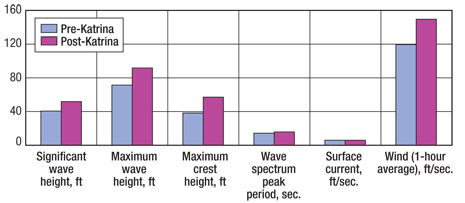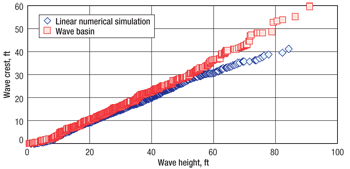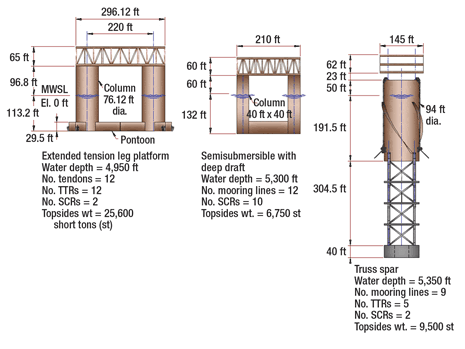Testing on the three most common types of floating structures in the Gulf of Mexico reveals considerable differences in how each responds to the new standards.
John Murray, FloaTEC, LLC
In the aftermath of recent hurricanes that passed through the Gulf of Mexico, the America Petroleum Institute (API) is making recommendations for assessing the behavior of existing deepwater Floating Production System (FPS) installations. The API has issued interim guidelines1 including new environmental criteria and procedures to ensure continued safety of these installations in the GOM. In accordance with the interim recommendation of the API committees, a set of metocean conditions has been defined for different regions in the Gulf of Mexico. In general, environmental design conditions have increased and will affect the response of the floating facilities currently installed.
Three of the most common types of deepwater floating structures used in the GOM are the semisubmersible, the TLP and the spar. The responses of these facility designs, including motions, air gaps, and riser and mooring tensions, will have to be reexamined for these new criteria.
Specialty deepwater FPS firm FloaTEC, LLC—a joint venture between J. Ray McDermott and Keppel Offshore & Marine, two leading global offshore companies—has versions of these hull types in the form of the Deep Draft Semisubmersible (DDS), the Extended Tension Leg Platform (ETLP) and the truss spar. The original designs of these hulls are based on a set of environmental criteria that are now superseded by new criteria resulting from observations of hurricane conditions in the Gulf of Mexico during Hurricane Katrina in August 2005.
This article compares the results of predicted responses on the designs of these structures based on pre-Katrina and post-Katrina hurricane environments. The results are based on a comparison of the responses of typical, but fictitious, designs of an ETLP, a DDS and a spar hull.
THE POST-KATRINA ENVIRONMENT
Figure 1 shows post-Katrina metocean conditions for the 100-year hurricane condition compared to the pre-Katrina environment. The figure compares waves, current and wind conditions. The largest increases in environmental conditions are in waves and wind. The increase in the associated current is comparatively marginal for the 100-year hurricane condition.
 |
|
Fig. 1. Comparison of pre-Katrina and post-Katrina, 100-year environments.
|
|
Many numerical modeling techniques to conduct hydrodynamic analysis on floating structures use a linear analysis, which is the linear summation of randomly selected sinusoidal components. This method can have certain limitations in achieving a prescribed maximum wave-crest height or a maximum wave height in a single simulation of waves in a storm environment.
Simulation of these environments for performance analysis of floating structures is generally based on numerical computer models and scaled physical-model tests. Wind forces are simulated using drag coefficients normally determined from wind tunnel tests. These coefficients relate wind velocity—defined by an API wind-velocity spectrum—to a wind-force spectrum. A similar method is used for current forces. Variations in current profile are modeled by stratifying the velocity into sections along the structure.
Figure 2 compares waves generated in a model test basin to a linear numerical simulation. The waves simulate a 100-year post-Katrina spectrum. The crests are plotted as a function of wave height. The comparison shows that the crest heights from the numerical simulation are about one-half of the wave heights. However, the waves measured in the model test basin have crests that are higher than one-half the wave height. Analysis of wave data acquired during Hurricane Katrina showed steep crests similar to those generated in the test basin.
 |
|
Fig. 2. Comparison of numerical wave simulation and wave basin simulations.
|
|
The most fundamental difference is that full-scale prototype waves can have highly nonlinear components that appear in the wave train as waves with steep crests and asymmetric profiles. Simulating a wave sequence from the linear summation technique may not achieve these conditions by simply summing harmonic components. In some cases, a trial-and-error approach can achieve the required profiles by changing the random seed number. Particular attention should be paid to this issue, especially when analyzing air gap and wave run-up on the hulls.
HULL FORM DIMENSIONS
Preliminary investigations into the reaction of existing hull designs to the new criteria illustrate the sensitivities of these hull forms to these new environments. Figure 3 shows the global dimensions of three typical hull forms currently deployed in the Gulf of Mexico, including some of the particulars, such as the assumed water depth and the number of mooring/tendon lines.
 |
|
Fig. 3. Details of structures analyzed for comparison.
|
|
The DDS has a chain-polyester-chain taut system, and the spar has chain-wire-chain semi-taut system. The DDS mooring system comprises four groups of three lines. The spar has a mooring system of three groups of three lines. The ETLP is attached to three tendons at each of the four corner porches. These designs are used to illustrate trends on the effects of the new environmental criteria on their respective responses.
ANALYSIS AND RESULTS
The results presented here are not intended to evaluate designs now installed in the Gulf of Mexico. The effect that the new environment might have on an existing installation would have to be addressed specifically for an individual installation. In any case, there are a number of options available for mitigating ramifications. For example, some adjustments can be made to the moorings, ballast management and local reinforcement of the structure if needed. Other considerations depend on the level of conservatism used in the original designs, such as multi-directional versus long crested wave conditions.
A summary of the percentage differences, increases and decreases in computed responses between the pre- and post-Katrina is provided in Table 1. Broad observations in these analyses are summarized as follows:
ETLP. In general, the ETLP exhibits the largest increases in offset motions. This is consistent with an increase in set-down and associated loss of air gap, which shows a reduction of about 19 ft. This air-gap loss is close to the differences in wave crest heights between the pre-Katrina and post-Katrina conditions. There is also a component to air-gap loss due to the increase in set-down. Increases in the rotational degrees of freedom, roll, pitch and yaw are negligible in comparison to those exhibited by the DDS and spar because of the constraints of the tendons.
The largest contribution to the increase in heave on the ETLP is the offset set-down. This set-down effect translates into an increase in the downward stroke range of approximately 3 ft between pre- Katrina and post-Katrina conditions. Increases in riser stroke will also be in the range of 3 ft for the ETLP because the Top Tensioned Risers (TTRs) and the hull experience similar set-down responses as the ETLP offsets.
Spar. The spar’s increase in surge is close to the same range as the DDS, while the sway increase is much less than the DDS. Thus, the total increase of offset combining both surge and sway is smaller than that of the DDS because of the highly nonlinear behavior of mooring restoring force on the spar at the extreme offset.
Rotational motions are smaller for the spar than for the DDS because the fairleaders are higher above the center of rotation and constrain the pitch and roll motions. This constraint is evident in the higher increase in mooring line tensions on the spar in comparison to the DDS. The air gap loss of 11 ft indicates that the maximum crest height could overtop the hard tank by approximately 3 ft. This could cause wave impact on the support structure for the deck.
DDS. The DDS has an increase in surge and sway of only 1% of the water depth. The increase in heave range is the highest of the three hull forms at about 11 ft. Also, due to its compliance to the incident environmental loads, the DDS has the largest increase in roll, pitch and yaw. These increased motions induce increased stresses in the steel catenary risers. Because of the position of the fairleaders on the DDS hull, the increase in mooring line tension is small in comparison to the increased tension in the spar moorings.
SUMMARY
A preliminary assessment of the sensitivities of deepwater floating production systems to the new Gulf of Mexico metocean criteria shows marginal increases on the motion responses and line tensions that may be accounted for within the original margins of design uncertainty. The most notable effect is in the loss of air gap, which can be directly related to increases in heave motion and increases in wave crest heights. The results of these analyses are not intended to be definitive but rather to illustrate the sensitivity of such design parameters as motions, mooring tensions and air gaps in the new environments. Any installation in the Gulf of Mexico will have to be specifically evaluated. 
LITERATURE CITED
1 Interim Guidance on Hurricane Conditions in the Gulf of Mexico, API Bulletin 2INT-MET, May 2007.
|
THE AUTHORS
|
| |
John Murray is Director of Technology Development at FloaTEC, LLC. Murray joined the National Research Council of Canada in 1986, working in R&D of offshore structures in clear water and ice-covered regions. In 1997, he joined Spars International Inc. in Houston. For the past 10 years, he has worked primarily in concept development for deepwater floaters and riser designs, both as a Principal Engineer with Technip Offshore, and, since 2006, as Director of Technology Development with FloaTEC. He directs and manages the overall development of FloaTEC’s technology, including tools and procedures to provide optimum sizes of floating system hulls as well as mooring and riser systems. Murray earned a PhD in ocean engineering, and has been published in numerous technical journals and conference proceedings. He holds a number of patents.
|
|
|





